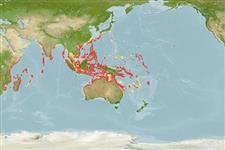Anthozoa |
Scleractinia |
Merulinidae
Environment: milieu / climate zone / depth range / distribution range
Ecology
Reef-associated; depth range 0 - 40 m (Ref. 847). Tropical; 36°N - 31°S, 34°E - 179°E (Ref. 847)
Western Central Atlantic and Indo-Pacific.
Length at first maturity / Size / Weight / Age
Maturity: Lm ? range ? - ? cm
Colonies are flabello-meandroid with wide v-shaped valleys that are evenly spaced. There are no columellae. Polyps have large tubular tentacles extending from large fleshy oral discs. Color is green with pink tentacle tips and a striped oral disc.
Has low to insignificant bleaching level in Palau (Ref. 66144). Also Ref. 847.
Life cycle and mating behavior
Maturity | Reproduction | Spawning | Eggs | Fecundity | Larvae
Members of the class Anthozoa are either gonochoric or hermaphroditic (Refs. 113712, 833). Mature gametes are shed into the coelenteron and spawned through the mouth. Life cycle: The zygote develops into a planktonic planula larva. Metamorphosis begins with early morphogenesis of tentacles, septa and pharynx before larval settlement on the aboral end (Ref. 833).
Ross, M.A. and G. Hodgson. 1981. (Ref. 8294)
IUCN Red List Status (Ref. 130435)
CITES status (Ref. 108899)
Not Evaluated
Threat to humans
Human uses
| FishSource |
Tools
Internet sources
Estimates based on models
Preferred temperature
(Ref.
115969): 24.9 - 29, mean 27.9 (based on 724 cells).
Price category
Unknown.
